Artist’s Statement
By
Prof. Alex J. Feingold
Background History
I am a mathematician, a Professor in the Department
of Mathematical Sciences at Binghamton University, where I started as
an Assistant Professor in 1979. My field is a branch of algebra with
strong connections to mathematical physics, but I have often been able
to use geometric ideas and intuition in my research. Many aspects of
mathematics are related to art, and many artists have used concepts
from mathematics in their work. But it is much more rare to find a
mathematician actually doing art. Of course, most good mathematicians
would say that they are doing art whenever they prove a beautiful
theorem, but it is a kind of abstract art, which would be difficult for
a non-mathematical audience to appreciate or understand!
Aside from the ``art” accomplished in my
professional work, I have had an interest in making art through
sculpture at least since 1978, when I met Prof. Helaman Ferguson at my
first math conference. He was the first professor to invite me, as a
new Ph.D., to give a talk at another university. At that time he was a
professor at Brigham Young University in Provo, Utah, and he was kind
enough to invite me to give a colloquium talk there. While staying at
his house for a week, he showed me his garage workshop, where he worked
on stone sculpture as a hobby. He gave me some soapstone and some
simple hand tools, and showed me how to shape and polish it into my
first stone sculpture, imitating one of his. I took some other stone
samples home with me, and made a few more, including one small marble
piece, which was much hard material to shape! Before that influential
meeting, I found an exhibition of kinetic sound sculptures by Harry
Bertoia at the Johnson Art Museum at Cornell University. I thought they
were so interesting that when I returned to Drexel University (my first
job in Philadelphia, 1977-79), I tried making some myself (with help
from Stanley Cohen in their metal shop). My first attempt at making a
kinetic sound sculpture was in brass, and the base plate warped badly
from the heat of welding, but the result was still interesting. Others
I made of iron with quite thin rods making a light sound. After moving
to Binghamton in 1979, I made a few more sculptures of various kinds,
stone, wood and metal. I donated a couple kinetic sound sculptures to
the WSKG (local public TV/radio station) Art Auction, but was never
able to sell any until I put pictures on my university webpage.
My friend Helaman gave up his position as
Professor at Brigham Young University to pursue his sculpture fulltime
as a profession. He moved to Laurel, Maryland, and began a new career.
He has been very successful, and is one of very few people making
mathematics into stone and bronze sculptures. He has been very
important to me as a mentor, a friend and an inspiration, and his work
is now on a very high and ambitious level, mostly working on large
granite pieces by commission. A couple years ago I went to him with a
question about how I might use bronze casting to reproduce copies of a
mahogany wooden sculpture I had made. He suggested that I try to
contact someone in the Art Department of my university, so that I might
learn how to do such a thing myself, and not just take it to a foundry
for others to copy. That led me to contact Prof. Jim Stark, whose open
and welcoming attitude, and endless patience and good advice have
allowed me to seriously pursue my interest in sculpture for the last
two years. In fact, using the facilities of the Binghamton University
sculpture studio, I have been able to make many bronze sculptures
through the lost wax method, and a few by direct metal welding. I now
have enough completed pieces to have an exhibition, but I have not had
an opportunity until now to do so.
I am very excited about recent opportunities to exhibit my sculptures.
Below I will give some details and descriptions of several of the
pieces I have been able to exhibit, including the ideas behind the
pieces. I include some figures and pictures of the pieces.
Descriptions and Organizing
Concepts
Kinetic
Sound Sculptures
I have already said that one of my early
inspirations was seeing and hearing the kinetic sound sculptures (KSS)
of Harry Bertoia. In case you are not familiar with these, let me
describe them briefly, and then explain what I have done with the
concept. Flexible metal rods are attached to a metal base plate in a
pattern so that when they are pushed (by hand or by wind) the tops sway
and hit each other, causing sound vibrations in the rods and base. The
tops of the rods may carry thicker rods, giving the appearance of
cattails, and changing the period of motion as well as the tone of the
sound. The base plate usually rests on adjustable ``feet”, screws which
can be used to level or attach the sculpture on the floor or table, and
which transmit the vibration. I always make my kinetic sound sculptures
with a special symmetrical rod pattern that comes from my mathematical
research area. For example, there is an eight dimensional Lie algebra
(said to be of type A2) whose adjoint representation has weight diagram
consisting of a regular hexagon including the point at the center. I
have made several versions of that 7-rod KSS with different size top
rods to give different sounds, all but one sculpture made from the same
kind of silicon-bronze alloy used for casting in the sculpture studio,
and one made from stainless steel. I usually make them by threading the
rods, tops and bases so that the pieces can be screwed together,
allowing disassembly for easy shipment. I have also made some 13-rod
KSS where the rod pattern comes from the adjoint representation of the
type G2 Lie algebra, which consists of a central point surrounded by
two hexagons of different sizes that fit together into a ``Star of
David” shown in Figure 1 below. The mathematical symmetries of these
patterns are captured by the Weyl group, which is a dihedral group
depending on the shape. There are infinitely many different possible
weight diagrams for each type of Lie algebra, but the patterns all have
the same basic Weyl group symmetries. The largest one I ever made was a
commission for a client in Chicago, designed for an outdoor garden and
consisting of 27 rods based on a high dimensional representation of the
type A2 Lie algebra. The pattern of rods is shown below in Figure 2.
Here I am exhibiting a 7-rod KSS whose bronze base plate is mounted on
a larger wooden base of polished black walnut which adds considerably
to the appearance, sound and balance. Pictures of this piece are shown
in Figure 3.
Figure 1: G2 Weight Diagram – 13 Rod
Pattern

Figure 2: Type A2 Weight Diagram – 27 Rod Pattern

Figure 3: 7 Rod Hexagon KSS - Two Views
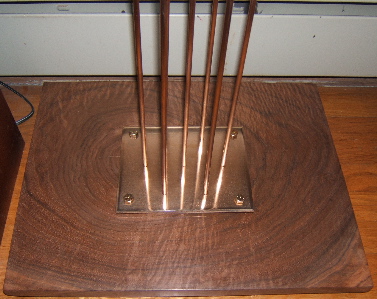
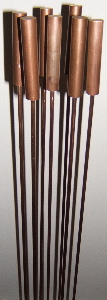
Knot
Sculptures
Several of my sculptures are related to the
topological theory of knots. A knot is a closed loop in space, which is
considered nontrivial if it curves around in such a way that it cannot
be continuously deformed into a simple circle. The simplest example of
such a nontrivial knot is the trefoil knot. When making such a knot
sculpture, one thinks first of choosing a shape for the cross-section,
that is, the shape of a slice at any point of the curve, perpendicular
to the path of the curve. I have made several sculptures based on the
trefoil knot, the simplest just from a bent rod (left over from a KSS!)
so the cross-section is just a circle. Another was cast with a
cross-section consisting of three circles, but it is not just three
parallel rods going around the knot separately. As they go around the
knot, they twist relative to each other, so that after going around the
knot once, the first rod leads into the second, the second into the
third, and the third into the first, making a single rod that goes
around the knot three times before closing the loop. This idea is
related to the mathematical concept of a fiber bundle, used in
differential geometry, where there is a big difference between the
local and the global structure of a manifold.
Two of the trefoil knots I have made were directly inspired by one made
by the sculptor John Robinson. He made the cross-section a rectangle,
and twisted it so that the rectangle formed a Mobius strip, the famous
one-sided figure made from a long strip of paper by curving it into a
cylinder, but giving a half-twist before connecting the ends. I made
one such Mobius trefoil in bronze by casting from a wax model, and
another by using the oxy-acetelyne torch to heat and bend a steel bar
into the twisted knot, finally welding the ends together. In each case,
I wanted the piece displayed in such a way that it could rotate in
space, and its reflection be seen from below, so I made a base plate as
I have used in my KSS, with a single rod in the center, its top
sharpened to a point, on which the knot is balanced. The plate is
polished so the viewer sees the reflection of the knot, but in the
steel version, the reflection was achieved by a sheet of plexiglass on
top of the plate. When struck by a hammer (a short metal rod provided
for that purpose), these knots produce a beautiful tone rich in
harmonics as the vibrations travel around and around the knot in both
directions! These sculptures should therefore be considered sound
sculptures. Pictures of these are shown in Figures 4 and 5. It is also
possible to hang these knots by wires from the ceiling, so that they
float just above the reflective bases. The short rod is used as a
hammer to make the knot ring.
Figure 4: Steel Trefoil Mobius Knot
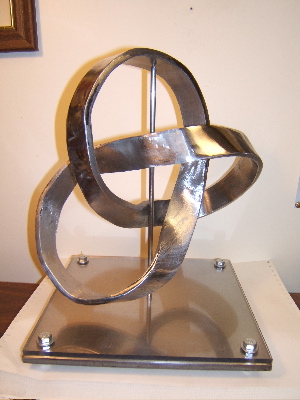
Figure 5: Bronze Trefoil Mobius Knot
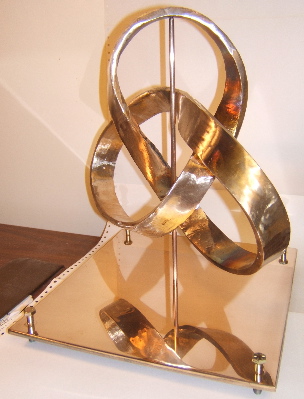
The third trefoil knot sculpture I have
exhibited has the cross-section of a curve called a hypocycloid. It is
the curve made by a chosen point on a moving circle of radius R as it
rolls (without slipping) inside a larger circle of radius 3R. This
curve looks like a triangle whose sides are slightly curved inward, and
is shown in Figure 6. I made a bronze cast knot about 9” across with
this hypocycloid cross-section, twisting as it goes around the knot in
such a way that the edges made by the three vertices form one
continuous edge that closes up only after three circuits of the knot.
In the same way, the three surfaces made by the curving edges of the
hypocycloid also form one continuous surface that takes three circuits
of the knot to repeat, similar to the Mobius strip. I display this
piece hanging over a base of polished black walnut, supported by a
bronze rod bent into a parabola, held by a thin steel wire, but easily
removed for handling. A short length of bronze rod is set in a hole in
the base and can be removed and used as a hammer to strike the knot,
producing a beautiful tone. The sculpture, which has been sold, is
shown in Figure 7.
Figure 6: Hypocycloid curve

Figure 7: Bronze Trefoil Hypocycloid Knot
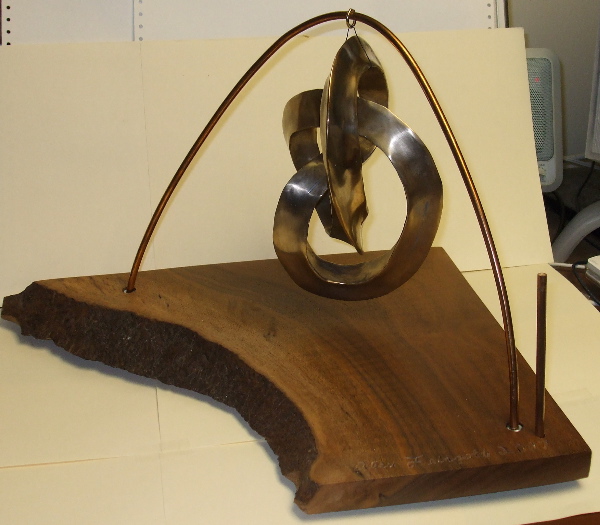
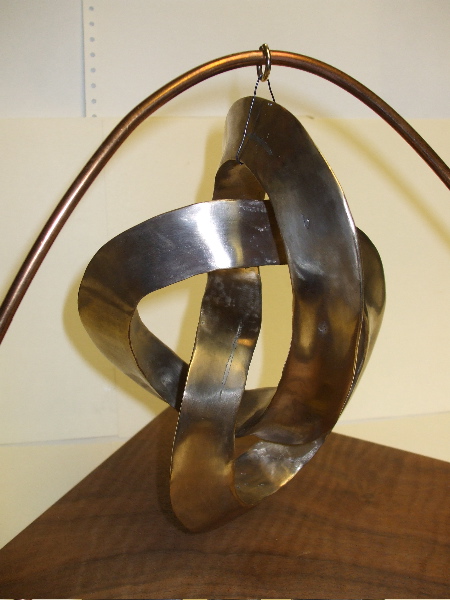
There are additional comments and pictures of
my work on my university internet webpages, which can be found using
any browser at the address:
http://www.math.binghamton.edu/alex/
under the heading ``Mathematical Sculptures by Alex Feingold”.
I would like to conclude with a statement of the goals and general
philosophy behind my work.
General Goals and Philosophy
Mathematics is the main inspiration for my
sculpture. I am certainly still trying to learn technique and
craftsmanship, exploring my limits and capabilities. There seem to be a
very large number of ideas from mathematics that lend themselves to
expression in sculpture, not just simple geometry, but using concepts
from quite advanced branches of math. I am very willing to study and
learn from others, but I hope I will eventually develop a unique voice
and vision of my own. I like best those small sculptures that can be
picked up and handled, so that the tactile impressions of the hands are
just as important as the image seen by the eyes. Surfaces, edges,
curvature and texture are the local characteristics felt, but the
larger global design is what appeals to the intellect and connects to
the wider world as well as to mathematical concepts. Motion and sound
are wonderful when incorporated into a sculpture, and I would like to
explore more ways of achieving that goal. I think my work will always
be on the abstract side, being mostly inspired by such concepts and
ideas rather than being representational. I greatly appreciate the
opportunity to exhibit some my work, and hope to get some reactions to
it from those in the art community.
Alex J. Feingold
Department of Mathematical Sciences
Binghamton University
This file last modified on December 2, 2007
Comments to alex@math.binghamton.edu












